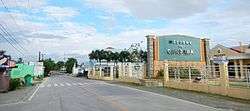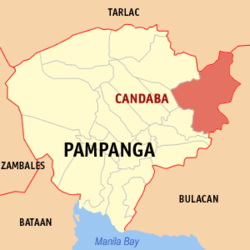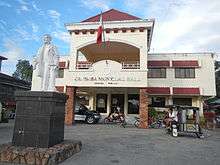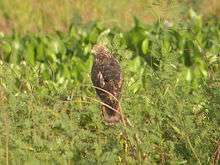Candaba, Pampanga
| Candaba Vizal Sto Cristo Candaba | ||
|---|---|---|
| Municipality | ||
 | ||
| ||
 Map of Pampanga showing the location of Candaba | ||
.svg.png) Candaba Location within the Philippines | ||
| Coordinates: 15°5′36″N 120°49′42″E / 15.09333°N 120.82833°ECoordinates: 15°5′36″N 120°49′42″E / 15.09333°N 120.82833°E | ||
| Country | Philippines | |
| Region | Central Luzon (Region III) | |
| Province | Pampanga | |
| District | 4th District | |
| Barangays | 33 | |
| Government[1] | ||
| • Mayor | Danilo Baylon | |
| Area[2] | ||
| • Total | 176.40 km2 (68.11 sq mi) | |
| Population (2010)[3] | ||
| • Total | 102,399 | |
| • Density | 580/km2 (1,500/sq mi) | |
| Time zone | PST (UTC+8) | |
| ZIP code | 2013 | |
| Dialing code | 45 | |
| Income class | 1st Class | |
Candaba (Kapampangan: Balen ning Candaba; formerly Candawe) is a first-class municipality in the province of Pampanga, Philippines. According to the 2010 census, it has a population of 102,399 people.[3]
Geography
Candaba represents the lowest point in Central Luzon Region of Luzon Island. The neighboring municipality of San Miguel (San Miguel de Mayumo) in Bulacan province used to be part of Candaba until San Miguel became a municipality itself.
Candaba's municipal boundaries are: Municipality of Arayat, Pampanga, and Municipality of Cabiao, Nueva Ecija, to the north; Municipality of San Miguel, Bulacan, and Municipality of San Ildefonso, Bulacan, to the east; Municipality of Baliuag, Bulacan, to the south; Municipality of San Luis, Pampanga, and Municipality of Santa Ana, Pampanga, to the west.
Barangays
Candaba is politically subdivided into 33 barangays.[2]
- Bahay Pare
- Bambang
- Barangca
- Barit
- Buas (Poblacion)
- Cuayang Bugtong
- Dalayap
- Dulong Ilog
- Gulap
- Lanang
- Lourdes
- Magumbali
- Mandasig
- Mandili
- Mangga
- Mapaniqui
- Paligui
- Pangclara
- Pansinao
- Paralaya (Poblacion)
- Pasig
- Pescadores (Poblacion)
- Pulong Gubat
- Pulong Palazan
- Salapungan
- San Agustin (Poblacion)
- Santo Rosario
- Tagulod
- Talang
- Tenejero
- Vizal San Pablo
- Vizal Santo Cristo
- Vizal Santo Niño
Climate
Like rest of the area in Central Luzon, there are two seasons in the area, the wet season and dry season. The wet season occurs during the months of May to October, and the dry season the rest of the year.
| Climate data for Candaba, Pampanga, Philippines | |||||||||||||
|---|---|---|---|---|---|---|---|---|---|---|---|---|---|
| Month | Jan | Feb | Mar | Apr | May | Jun | Jul | Aug | Sep | Oct | Nov | Dec | Year |
| Average high °C (°F) | 29 (84) |
31 (88) |
32 (90) |
34 (93) |
34 (93) |
31 (88) |
30 (86) |
30 (86) |
30 (86) |
30 (86) |
30 (86) |
29 (84) |
30 (86) |
| Average low °C (°F) | 20 (68) |
19 (66) |
21 (70) |
22 (72) |
23 (73) |
23 (73) |
23 (73) |
23 (73) |
23 (73) |
22 (72) |
21 (70) |
20 (68) |
21 (70) |
| Average precipitation cm (inches) | 1.7 (0.7) |
0.7 (0.3) |
0.5 (0.2) |
2.4 (0.9) |
15.3 (6) |
35.5 (14) |
50.4 (19.8) |
51.6 (20.3) |
37.4 (14.7) |
22.5 (8.8) |
16.3 (6.4) |
6.8 (2.7) |
240.8 (94.8) |
| Source: http://www.weatherbase.com/weather/weather.php3?s=984300&refer=&units=metric | |||||||||||||
Demographics
| Population census of Candaba | ||
|---|---|---|
| Year | Pop. | ±% p.a. |
| 1990 | 68,145 | — |
| 1995 | 77,546 | +2.45% |
| 2000 | 86,066 | +2.26% |
| 2007 | 96,589 | +1.60% |
| 2010 | 102,399 | +2.15% |
| Source: National Statistics Office[3][4] | ||
Religion
Roman Catholic 90%, Members Church of God International 3.5%, Iglesia ni Cristo 3%, Evangelicals 2%, others (includes Islam, Buddhism and other religions) 1.5%. The Saint Andrew church serves as one of the Roman Catholic parish churches inside the municipality.
The most popular religious site in Candaba is in the barangay "Pulong Gubat". It pulls many pilgrims who believe that Nuestra Señor dela Pacencia will cure their illness or grant their wishes.
Local government

Mayor of Candaba is Baylon Danilo, and vice mayor is Michael V. Sagum, replacing Rene Maglanque and Babes Evangelista respectively after the 2016 mayoral elections.[1]
Economy
The Candaba Swamp (Pinac, Pinak) absorbs most of the flood waters that flow from the western slopes of the Sierra Madre Mountain Range. During the rainy season, the Pampanga River overflows and the swamp is submerged. But it is relatively dry during the dry Season, hence making the land suitable for a variety agricultural production.
Candaba is noted for its production watermelon, that are sold worldwide. The swamps are communal fishing grounds encompassing some 430 km2 of highly arable farmlands. Candaba swamps are very fertile due to its sustained deposits of humus and decaying plant residues. Migrant wild ducks and various wildlife bird from Siberia, New Zealand, Mongolia and other parts of Asia use Candaba as their yearly sanctuary.
Infrastructure
- Roads
Candaba-San Miguel road or pinak was fully cemented by 2014. This was one of the former mayor Jerry Pelayo's major projects. The construction stopped when the ex-mayor didn't won when he ran for governor. But then it was continued by the present mayor, (2015) Rene Maglangque and is planning for the whole road to be asphalted, though some parts of it was already asphalted.
- Drainage System
Candaba-San Miguel road is known for being flooded when a typhoon hits Candaba. The drainage system or rip-rap, which is a part of Mayor Jerry Pelayo's road cementing project, was built on both sides of every cemented roads made so the rainwater from other parts of Pampanga will just flow on it and not on the road.
Transportation
Public transport is mainly done by means of jeepneys and tricycles. Jeepneys have their routes as an itinerary route for various places.
Telecommunication facilities
Candabas telecommunication facilities and telephone services are provided by the Philippine Long Distance Telephone Company (PLDT), PSE.DGTL, Datelcom, Evangelista Telephone Company and the Pampanga Telecom Company.
Water and power utilities
- Waterworks
Candaba will soon have modern waterworks, following the start of a 24 million Peso water supply development project of the Candaba Water District (CWD) with the financial and technical assistance of the Local Water Utilities Administration (LWUA). Other means to get drinking water are water wells.
- Electric power
The municipality receives it electric power in from the Pampanga Electric Cooperative (PELCO) and from Manila Electric Company (MERALCO).
Bird sanctuary

On January 2008, a Philippine record of 17,000 birds (in the 24-hour count) visited the 32,000-hectare Candaba Swamp, sanctuary for migratory birds. Michael Lu, president of the Wild Bird Club of the Philippines (WBCP), stated that 80 species of migratory birds were sighted at the 100-hectare fishpond of Mayor Jerry Pelayo in Barangay Doña Simang and in Barangay Paralaya. The rare birds spotted were: the Shrenck’s bittern, great bittern, gadwall, coot, Philippine mallard or ducks, and Eurasian spoonbill (Platalea leucorodia). Robert S. Kennedy’s book A Guide to the Birds of the Philippines lists endemic and migratory birds which visit the Philippines. Pelayo organized the Ibon-Ebon Festival (“birds and eggs”) on February 1–2. The WBCP recorded three rare species in Candaba swamp: the purple swamphen (Porphyrio porphyrio), Chinese pond heron (Ardeola bacchus) and the black-crowned night heron (Nycticorax nycticorax).[5]
References
- 1 2 "Official City/Municipal 2013 Election Results". Intramuros, Manila, Philippines: Commission on Elections (COMELEC). 1 July 2013. Retrieved 17 September 2013.
- 1 2 "Province: Pampanga". PSGC Interactive. Makati City, Philippines: National Statistical Coordination Board. Archived from the original on 14 November 2012. Retrieved 12 December 2012.
- 1 2 3 "Total Population by Province, City, Municipality and Barangay: as of May 1, 2010" (PDF). 2010 Census of Population and Housing. National Statistics Office. Archived from the original (PDF) on 15 November 2012. Retrieved 12 December 2012.
- ↑ "Province of Pampanga". Municipality Population Data. LWUA Research Division. Retrieved 16 August 2013.
- ↑ Inquirer.net, 17,000 birds sighted in Candaba swamp
Bibliography
- Gatbonton, Manuel, Ing Candawe, excerpts, 1933.
- Henson, Mariano A., Pampanga and Its Towns (AD 1300-1965), Angeles: 1965.
- Licuanan, Virginia Benitez and Jose Llavador Mira, The Philippines Under Spain: A Compilation and Translation of Original Documents, Quezon City: 1993.
- Pangilinan, Michael Raymon M. (Siuala ding Meangubie), Five Thousand Years of Antiquity: A Timeline of Candaba History, Kapampangan Magazine, ed. by Elmer G. Cato, ISSN 1656-5592, Year 2004, Issue XV, pp. 11–12.
- Pangilinan, Michael Raymon M. (Siuala ding Meangubie), Candaba: Timelessly Mystical, Kapampangan Magazine, ed. by Elmer G. Cato, ISSN 1656-5592, Year 2004, Issue XV, pp. 16–17.
- San Agustin, Gaspar de, Conquistas de las Islas Filipinas; 1565–1615, 1st Bilingual Edition, Intramuros: 1998.
- The Historical Data Papers, Candaba, Bureau of Public Schools, 1953
- The Contemporary Chinese Dictionary (Chinese-English Edition), Foreign Language Teaching and Research Press, Beijing 2002.
External links
| Wikimedia Commons has media related to Candaba, Pampanga. |
- Philippine Standard Geographic Code
- Philippine Census Information
- Local Governance Performance Management System
 |
Arayat | Cabiao, Nueva Ecija | San Isidro, Nueva Ecija |  |
| Santa Ana | |
San Miguel, Bulacan San Ildefonso, Bulacan | ||
| ||||
| | ||||
| San Luis | Baliuag, Bulacan | San Rafael, Bulacan |